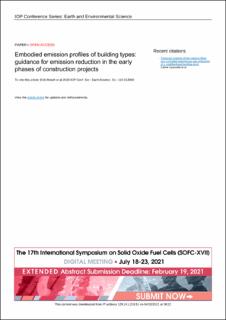| dc.contributor.author | Resch, Eirik | |
| dc.contributor.author | Brattebø, Helge | |
| dc.contributor.author | Andresen, Inger | |
| dc.date.accessioned | 2021-02-19T15:32:54Z | |
| dc.date.available | 2021-02-19T15:32:54Z | |
| dc.date.created | 2020-04-23T23:11:34Z | |
| dc.date.issued | 2020 | |
| dc.identifier.issn | 1755-1307 | |
| dc.identifier.uri | https://hdl.handle.net/11250/2729319 | |
| dc.description.abstract | The embodied emissions of the construction materials in buildings are a significant contributor to climate change but have only rarely been systematically studied by statistical methods. In the early phases of a building project, empirical results of statistical emission profiles of different building types can act as useful guiding information to inform decisions regarding reduced embodied emissions from construction materials. However, engineers and architects do not have such information at disposition. In this paper, the embodied emissions from the production and transport of initial and recurring building material use in 7 Norwegian case studies of low-emission buildings are made comparable and then studied statistically to find out how the impact varies with building types. The building types studied are timber residential, concrete office, concrete school, and concrete swimming hall. Statistics are produced for each building type and are broken down by the impact contribution from different building elements and material categories. This results in embodied emission profiles and material use profiles for these four building types, which, when based on a larger dataset, can be used by architects and engineers to make informed decisions when aiming for reduced embodied emissions in the early phases of a construction project. Additionally, these profiles can be used as benchmarks by which the final building can be compared when the building is constructed. The statistical results are preliminary and based on a limited dataset, which makes them applicable only as an indication for Norwegian low-emission buildings of these four building types. Future work includes expansion of the dataset on which the profiling is based, further development of the statistical method, and applying the methodology to additional building types. | en_US |
| dc.language.iso | eng | en_US |
| dc.publisher | IOP Publishing | en_US |
| dc.rights | Navngivelse 4.0 Internasjonal | * |
| dc.rights.uri | http://creativecommons.org/licenses/by/4.0/deed.no | * |
| dc.title | Embodied emission profiles of building types: Guidance for emission reduction in the early phases of construction projects | en_US |
| dc.type | Peer reviewed | en_US |
| dc.type | Journal article | en_US |
| dc.description.version | publishedVersion | en_US |
| dc.source.volume | 410 | en_US |
| dc.source.journal | IOP Conference Series: Earth and Environmental Science (EES) | en_US |
| dc.source.issue | 1 | en_US |
| dc.identifier.doi | 10.1088/1755-1315/410/1/012069 | |
| dc.identifier.cristin | 1807772 | |
| dc.relation.project | Norges forskningsråd: 257660 | en_US |
| dc.description.localcode | Content from this work may be used under the terms of the Creative Commons Attribution 3.0 licence. Any further distribution of this work must maintain attribution to the author(s) and the title of the work, journal citation and DOI. Published under licence by IOP Publishing Ltd | en_US |
| cristin.ispublished | true | |
| cristin.fulltext | original | |
| cristin.qualitycode | 1 | |

